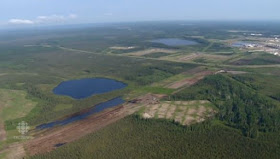Alberta oil spill: When ‘failsafe’ leak detection systems fail
Aerial images show the bitumen emulsion spill at Nexen's Long Lake site.
Global News
Global News
In fact, a 2012 study by the U.S. Department of Transportation’s Pipeline and Hazardous Materials Safety Administration found that leak detection systems only detected spills on a company’s right-of-way 11 per cent of the time. Far more often, leaks are discovered by emergency responders, members of the public or, as was the case this week, a company employee. By then, as was the case with the 5,000-cubic-metre Nexen spill, enormous amounts of bitumen, oil or emulsion can be released.
Alberta pipeline spill
Ron Bailey, Nexen’s senior vice-president of Canadian operations, said the company is “sincerely sorry” about the spill and is investigating what went wrong.
“This is a modern pipeline. We have pipeline integrity equipment, in fact some very good equipment,” he said. “Our investigation is looking at exactly why that wasn’t alerting us earlier.”
Most oil and gas companies have pipeline leak detection systems in place, Swift said. They just tend not to detect many leaks.
“Unfortunately, a leak detected by a pipeline’s leak detection system tends to be the exception to the rule,” he said.Many leak detection systems, Swift said, measure the difference between the volume at one end of a pipeline and compare it to the volume at the other end. Others measure changes in pressure.
“The vast majority of leaks are identified by landowners or intermittent flyovers. And by that time, they can be quite large.”
But both those methods are vulnerable to a high number of false positives, the U.S. study found: A whole host of factors can cause volume or pressure to change. And even if you do know there’s a leak, systems that only measure endpoint pressure or volume make it tough to find exactly where on an enormous pipeline a rupture is.
“Regulators haven’t required substantial improvements in leak detection technologies. And because there’s little regulatory pressure to improve outcomes … pipeline companies aren’t incentivizing technology companies to create better systems,” Swift said.It would help for regulators to require redundancy — multiple leak detection systems all working at once, so if one of them misses a leak, another one will catch it. Germany requires this, Swift said.
“It’s hard to imagine a pipeline operator being legitimately surprised their leak detection system didn’t work,” Swift said.He’s hopeful massive pipeline failures such as Nexen’s spill this week will lead the public and regulatory bodies to demand better leak detection systems.
“The public hasn’t been aware of the issues associated with leak detection,” he said.
“As we see a litany of spills happening across North America and leak detection problems become a consistent issue, that very well may change.”And as Canada debates whether to approve new large-scale energy projects, the issue couldn’t be more timely.
“This is a timely discussion to be having,” Swift said.
“The pipeline industry purports to have safety measures which oftentimes are pitched as much stronger than they are.”



































